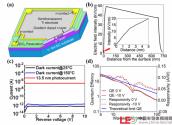Interesting achievement, that's could allow them to accurate calibrate EUV components.
Recently, the team of Professor Lu Hai and Zhang Rong of Nanjing University has innovatively designed a surface gradient doping induced δn-ip ultra-shallow junction SiC diode based on previous research, and developed selective etching, high temperature oxidation repair and low temperature metallization. process, successfully realized the world's first wide-bandgap semiconductor pn junction EUV detector (Figure 2(a)).
Numerical simulation and experimental results show that the δn-ip structure formed by concentration gradient doping can induce a strong electric field on the detector surface consistent with the electric field direction of the pn junction region inside the device (Fig. 2(b)), thereby effectively reducing photogenerated carriers The recombination loss in the dead zone of the device surface greatly improves the detection efficiency of the device. A series of on-chip characterization and packaging tests prove that the EUV detector has the advantage of detection efficiency close to the theoretical limit; at the same time, compared with the Schottky junction detector, the pn junction is less affected by the interface state, leakage current and ambient temperature changes, and its performance more stable. As shown in Figure 2(c), the dark current of this large-scale EUV detector is only 1pA@-10V at room temperature, which has the superior performance of detecting weak light signals; The dark current of the detector is only 2pA@-10V, which has the application potential of working in high temperature environment; the photocurrent of the detector under 13.5 nm EUV light irradiation does not change with the bias voltage, which proves that the device can be used in photovoltaic work in mode.
Furthermore, the quantum efficiency of the device in photovoltaic mode is as high as 960%@13.5nm, which is close to the theoretical limit of SiC EUV detectors (Fig. 2(d)). The related research results will be published online in IEEE Electron Device Letters 43:906, 2022 with the title of "4H-SiC δn-ip extreme ultraviolet detector with gradient doping-induced surface junction" in May 2022; among them, doctoral student Wang Zhiyuan is the first The first author and the corresponding author is Professor Lu Hai.

Fig.2 SiC δn-ip EUV detector (a) device structure diagram; (b) TCAD simulation device surface electric field distribution; (c) dark current and photocurrent characteristic curves at room temperature and 150°C; (d) detection efficiency curve.
The Nanjing University team has a good research foundation in the field of wide-bandgap semiconductor UV detectors, and has achieved large-scale promotion and application of multiple types of high-performance semiconductor UV detectors. The team has been developing short-wave UV detectors below 200 nm since 2011. In 2013, the team first realized a large photosensitive surface and wide bandgap AlGaN-based vacuum UV detector with a detection wavelength as low as 140 nm (Chinese Physics Letters 30: 117301, 2013), which is the first semiconductor vacuum ultraviolet detector publicly reported in China.

